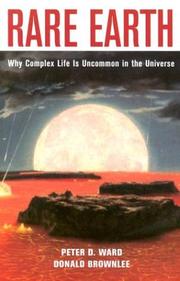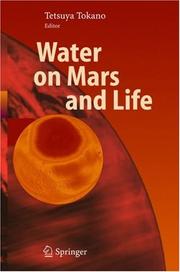| Listing 1 - 4 of 4 |
Sort by
|
Periodical
ISSN: 1349967X 09149201 Year: 1987 Publisher: Sagamihara, Japan : Japanese Society for Biological Sciences in Space,
Abstract | Keywords | Export | Availability | Bookmark
 Loading...
Loading...Choose an application
- Reference Manager
- EndNote
- RefWorks (Direct export to RefWorks)
Space biology --- Space medicine --- Exobiology --- Space Flight. --- Extraterrestrial Environment. --- Cosmic Radiation. --- Exobiology. --- Space biology. --- Space medicine. --- Life Sciences --- Biology --- Aerospace medicine --- Bioastronautics --- Cosmobiology --- Astrobiology --- Extraterrestrial Life --- Life, Extraterrestrial --- Radiation, Cosmic --- HZE Particles --- Cosmic Radiations --- HZE Particle --- Particle, HZE --- Particles, HZE --- Radiations, Cosmic --- Environment, Extraterrestrial --- Space (Astronomy) --- Environments, Extraterrestrial --- Extraterrestrial Environments --- Spaces (Astronomy) --- Spaceflight --- Space Exploration --- Exploration, Space --- Explorations, Space --- Flight, Space --- Flights, Space --- Space Explorations --- Space Flights --- Spaceflights --- Medicine --- Space sciences --- Transportation medicine --- Aviation medicine --- Habitable planets --- Life --- Extraterrestrial Environment --- Solar Activity --- Space Flight --- Planets --- Space Travel --- Space Travels --- Travel, Space --- Travels, Space --- Aerospace Medicine --- Origin --- Space Biology --- Biologies, Space --- Biology, Space --- Space Biologies --- Space Research

ISBN: 1280187743 9786610187744 0387218483 0387987010 9780387987019 9780387952895 0387952896 Year: 2000 Publisher: New York : Copernicus,
Abstract | Keywords | Export | Availability | Bookmark
 Loading...
Loading...Choose an application
- Reference Manager
- EndNote
- RefWorks (Direct export to RefWorks)
n November 12, 2002, Dr. John Chambers of the NASA Ames - search Center gave a seminar to the Astrobiology Group at the OUniversity of Washington. The audience of about 100 listened with rapt attention as Chambers described results from a computer study of how planetary systems form. The goal of his research was to answer a dec- tively simple question: How often would newly forming planetary systems produce Earth-like planets, given a star the size of our own sun? By “Ear- like” Chambers meant a rocky planet with water on its surface, orbiting within a star’s “habitable zone. ” This not-too-hot and not-too-cold inner - gion, relatively close to the star, supports the presence of liquid water on a planet surface for hundreds of million of years—the time-span probably n- essary for the evolution of life. To answer the question of just how many Earth-like planets might be spawned in such a planetary system, Chambers had spent thousands of hours running highly sophisticated modeling p- grams through arrays of powerful computers. x Preface to the Paperback Edition The results presented at the meeting were startling. The simulations showed that rocky planets orbiting at the “right” distances from the central star are easily formed, but they can end up with a wide range of water c- tent.
Life on other planets. --- Exobiology. --- Exobiology --- Extraterrestrial Environment. --- Origin of Life. --- Environment, Extraterrestrial --- Space (Astronomy) --- Environments, Extraterrestrial --- Extraterrestrial Environments --- Spaces (Astronomy) --- Space Flight --- Astrobiology --- Extraterrestrial Life --- Life, Extraterrestrial --- Extraterrestrial Environment --- Habitable planets --- Extraterrestrial life --- Fermi's paradox --- Genesis of Life --- Life Geneses --- Life Genesis --- Life Origin --- Life Origins --- Popular works. --- Science. --- Astrobiology. --- Astronomy. --- Popular Science. --- Popular Science in Astronomy. --- Science, general. --- Organelle Biogenesis --- Planets --- Biology --- Life --- Origin --- Life on other planets --- Vie extraterrestre --- Exobiologie --- Science, Humanities and Social Sciences, multidisciplinary. --- Space Biology --- Biologies, Space --- Biology, Space --- Space Biologies --- Space Research --- Origin of Life --- Prebiotic Chemical Evolution --- Chemical Evolution, Prebiotic --- Evolution, Prebiotic Chemical --- Prebiotic Chemical Evolutions
Periodical
ISSN: 03215044 Year: 1974 Publisher: Moskva, Medit͡sina.
Abstract | Keywords | Export | Availability | Bookmark
 Loading...
Loading...Choose an application
- Reference Manager
- EndNote
- RefWorks (Direct export to RefWorks)
Space medicine --- Space biology --- Space biology. --- Space medicine. --- Aerospace Medicine. --- Extraterrestrial Environment. --- Space Flight. --- Space Travel --- Spaceflight --- Space Exploration --- Exploration, Space --- Explorations, Space --- Flight, Space --- Flights, Space --- Space Explorations --- Space Flights --- Space Travels --- Spaceflights --- Travel, Space --- Travels, Space --- Aerospace Medicine --- Environment, Extraterrestrial --- Space (Astronomy) --- Environments, Extraterrestrial --- Extraterrestrial Environments --- Spaces (Astronomy) --- Space Flight --- Planets --- Exobiology --- Medicine, Aerospace --- Medicine, Aviation --- Medicine, Space --- Aviation Medicine --- Space Medicine --- Air Travel --- Aerospace medicine --- Bioastronautics --- Medicine --- Space sciences --- Transportation medicine --- Aviation medicine --- Cosmobiology --- Biology --- Aeronautics --- Flight --- Medical aspects --- Health Sciences --- Clinical Medicine

ISBN: 9783540206248 3540206248 9786611389673 1281389676 3540315381 Year: 2005 Publisher: Berlin, Heidelberg : Springer Berlin Heidelberg : Imprint: Springer,
Abstract | Keywords | Export | Availability | Bookmark
 Loading...
Loading...Choose an application
- Reference Manager
- EndNote
- RefWorks (Direct export to RefWorks)
Growing evidence, based on observations from orbiters, landers and telescopes, indicates that Mars may still have numerous hidden water reservoirs. Moreover, from the point of view of habitability, Mars is a prime target for astrobiologists in search of extant or extinct microbial life because we know that life exists in earth’s permafrost regions, such as parts of Siberia and the Antarctic, which are the closest terrestrial analogues to Mars. "Water on Mars and Life" surveys recent advances made in research into water on Mars together with its astrobiological implications. This volume addresses not only scientists working in the field but also nonspecialists and students in search of a high-level but accessible introduction to this exciting field of research.
Exobiology. --- Exobiologie --- Mars (Planet) --- Mars (Planète) --- Water. --- Geology. --- Eau --- Géologie --- Physics. --- Life sciences. --- Physical geography. --- Astrophysics. --- Astrobiology. --- Extraterrestrial Physics, Space Sciences. --- Biogeosciences. --- Geophysics/Geodesy. --- Exobiology --- Water --- Evolution, Planetary --- Mars --- Extraterrestrial Environment --- Hydroxides --- Geological Processes --- Astronomical Objects --- Astronomical Processes --- Planets --- Biology --- Oxides --- Environment --- Solar System --- Biological Science Disciplines --- Ecological and Environmental Phenomena --- Astronomical Phenomena --- Physical Processes --- Geological Phenomena --- Inorganic Chemicals --- Oxygen Compounds --- Physical Phenomena --- Biological Phenomena --- Chemicals and Drugs --- Natural Science Disciplines --- Phenomena and Processes --- Disciplines and Occupations --- Astrophysics --- Astronomy & Astrophysics --- Physical Sciences & Mathematics --- Natural Sciences --- Physical Sciences --- Discipline, Natural Science --- Disciplines, Natural Science --- Natural Science --- Natural Science Discipline --- Physical Science --- Science, Natural --- Science, Physical --- Sciences, Natural --- Sciences, Physical --- Biologic Phenomena --- Biological Phenomenon --- Biological Process --- Phenomena, Biological --- Biological Processes --- Phenomena, Biologic --- Phenomenon, Biological --- Process, Biological --- Processes, Biological --- Physical Phenomenon --- Physical Process --- Physical Concepts --- Concept, Physical --- Concepts, Physical --- Phenomena, Physical --- Phenomenon, Physical --- Physical Concept --- Process, Physical --- Processes, Physical --- Chemicals, Inorganic --- Geological Phenomenon --- Geological Process --- Geophysical Phenomena --- Geophysical Process --- Geophysical Processes --- Geological Concepts --- Concept, Geological --- Concepts, Geological --- Geological Concept --- Phenomena, Geological --- Phenomena, Geophysical --- Phenomenon, Geological --- Process, Geological --- Process, Geophysical --- Processes, Geological --- Processes, Geophysical --- Astronomic Concepts --- Astronomic Phenomena --- Astronomic Phenomenon --- Astronomic Process --- Astronomic Processes --- Astronomical Concepts --- Astronomical Process --- Astrophysical Concepts --- Astrophysical Phenomena --- Astrophysical Phenomenon --- Astrophysical Processes --- Astronomic Concept --- Astronomical Concept --- Astrophysical Concept --- Concept, Astronomic --- Concept, Astronomical --- Concept, Astrophysical --- Concepts, Astronomic --- Concepts, Astronomical --- Concepts, Astrophysical --- Phenomena, Astronomic --- Phenomena, Astronomical --- Phenomena, Astrophysical --- Phenomenon, Astronomic --- Phenomenon, Astrophysical --- Process, Astronomic --- Process, Astronomical --- Processes, Astronomic --- Processes, Astronomical --- Processes, Astrophysical --- Ecological and Environmental Concepts --- Ecological and Environmental Processes --- Biologic Sciences --- Biological Science --- Science, Biological --- Sciences, Biological --- Biological Sciences --- Life Sciences --- Biologic Science --- Biological Science Discipline --- Discipline, Biological Science --- Disciplines, Biological Science --- Life Science --- Science Discipline, Biological --- Science Disciplines, Biological --- Science, Biologic --- Science, Life --- Sciences, Biologic --- Sciences, Life --- Satellites, Natural --- Sun --- Natural Satellite --- Natural Satellites --- Satellite, Natural --- System, Solar --- Environmental Impact --- Environmental Impacts --- Impact, Environmental --- Impacts, Environmental --- Environments --- Planet --- Astrobiology --- Extraterrestrial Life --- Life, Extraterrestrial --- Environment, Extraterrestrial --- Space (Astronomy) --- Environments, Extraterrestrial --- Extraterrestrial Environments --- Spaces (Astronomy) --- Deimos --- Phobos --- Planetary Evolution --- Hydrogen Oxide --- Astronomical physics --- Biosciences --- Natural philosophy --- Philosophy, Natural --- Compounds, Oxygen --- Astronomic Objects --- Astronomic Object --- Astronomical Object --- Object, Astronomic --- Object, Astronomical --- Objects, Astronomic --- Objects, Astronomical --- Geophysics. --- Geobiology. --- Space sciences. --- Space Sciences (including Extraterrestrial Physics, Space Exploration and Astronautics). --- Habitable planets --- Life --- Geography --- Astronomy --- Cosmic physics --- Physics --- Origin --- Geological physics --- Terrestrial physics --- Earth sciences --- Biosphere --- Science and space --- Space research --- Cosmology --- Science
| Listing 1 - 4 of 4 |
Sort by
|

 Search
Search Feedback
Feedback About UniCat
About UniCat  Help
Help News
News